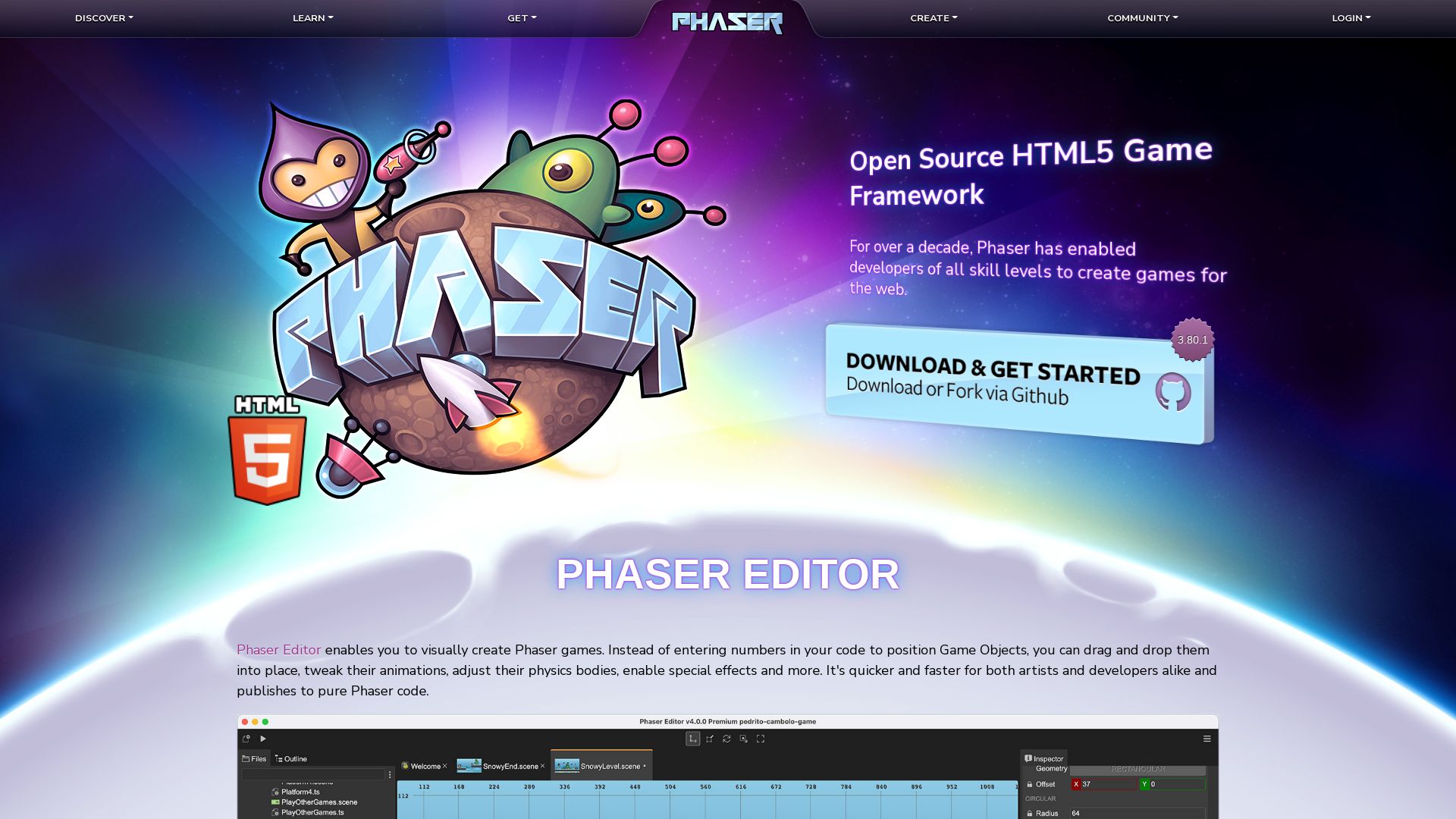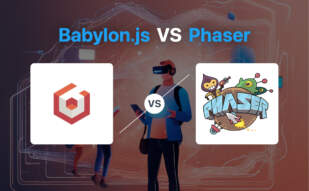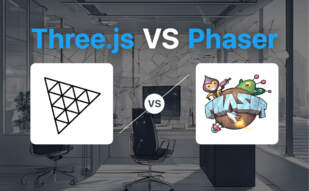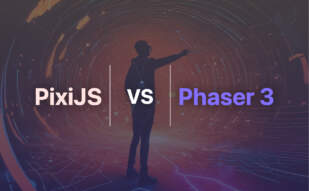Phaser 3 is a cutting-edge HTML5 game framework that offers a brand-new custom WebGL renderer tailored for modern 2D games. With a focus on a data-oriented approach and a modular structure, Phaser 3 is built to enhance game development experiences on both desktop and mobile platforms. Led by Richard Davey, Phaser 3 has garnered support from developers and Patreon members, ensuring its continuous growth and improvement since its official release on February 13th, 2018.

Looking for diverse alternatives to Phaser 3? Options include WebGL, WebGL 2, WebVR, WebXR, OpenXR, React Three Fiber, p5.js, Pixi.js, Babylon.js, A-Frame, X3DOM, Deck.gl, and VTK.js.
Phaser

Enter the realm of Phaser, a dynamic 2D game framework. An evolution in HTML5 games for both desktop and mobile, Phaser was crafted by Richard Davey and saw its initial release in April 2013. Utilizing JavaScript and TypeScript, Phaser leverages Canvas and WebGL renderer, delivering swift rendering and automatically switches based on your browser’s support.
Phaser Top Features
- Freedom to deploy games to iOS, Android, and native desktop apps using Apache Cordova and PhoneGap.
- Extensive Phaser versions, including Phaser 1 which includes Pixi.js library, Phaser 2 and its final version 2.6.2, Phaser CE as the currently recommended stable platform, Phaser 3 with its custom WebGL renderer and modular structure, and the in-development Phaser 4 which will be a TypeScript rewrite of Phaser 3.
- Game project typically includes Scripts/js folders, src folder, assets folder, and Index.html for a comprehensive game development experience.
- Highly compatible with any browser supporting canvas element.
- Support for multiple physics systems such as Arcade Physics, Ninja Physics, P2.JS.
- Web and HTML5 audio compatibility for sound playback.
| Feature | Detail |
| Examples & Community | Get inspired with over 1800+ examples and active community support. |
| Flexible Usage | Adapt to various gaming environments like es6+webpack, CDN, TypeScript, Android games, and Facebook Instant games. |
| Learning Resources | Utilize Phaser’s robust learning resources and Phaser Mini-Degree from Zenva Academy. |
Phaser Limitations
- Limited to 2D game development.
- Depends on browser’s support for Canvas and WebGL renderer.
Phaser Pricing
Phaser glows as a free, open-source platform, providing affordable access to game developers.
Phaser Use Cases
Use case 1: Indie Game Development
With its comprehensive resources and robust framework, Phaser is an ideal choice for indie game developers who are looking to master 2D game creation and deployment to various platforms.
Use case 2: Interactive Web Content Creation
Phaser’s compatibility with HTML5 audio and various physics systems make it a powerful tool for creating interactive web content.
Use case 3: Educational Purposes
The ample examples and community support that Phaser provides can be utilized in an educational setting to provide hands-on learning experiences for students interested in game development.
PixiJS
PixiJS is an advanced rendering system that displays 2D visuals using either WebGL or Canvas. A replacement for Flash in HTML5, it is perfect for graphics-intensive web applications, online games, interactive ads, and educational content.
PixiJS Top Features
- High Speed: Thanks to automatic sprite & geometry batching and optimal WebGL usage.
- Variety of Visuals: Not limited to sprites. You can draw trails, primitives and it even provides text rendering.
- Native Spritesheets: Ease loadings and simplify development.
- WebGL Native: Fast rendering and advanced effects achieved through Filter class and shader programs.
- Open Source: With fully accessible code, hosted on GitHub, under the MIT license.
- Extensible: Clean internal API across its 5 major versions.
- Easy to Deploy: Website-like deployment that can be extended for mobile & desktop apps via Cordova & Electron.
| Feature | Description |
|---|---|
| Aims | Fast, 2D rendering system that works across all devices and user-friendly |
| Learning resources | Official website, tutorials, API guide, Wiki, Discord chat |
| Setup | Download prebuilt build, npm install or CDN URL use |
PixiJS Limitations
- Despite its many features, PixiJS is not a game engine. It is a ‘creation engine’ designed for swiftly moving things on screens.
- The platform is maintained and updated primarily by Mat Groves and the community. Bugs reported are fixed via GitHub, meaning a speedy addressal can’t always be guaranteed.
PixiJS Pricing
PixiJS is entirely free and open-source. Any financial contributions made are intended solely to accelerate the platform’s development.
PixiJS Use Cases
Use case 1 – Web Applications
PixiJS is ideal for graphics-heavy web applications, as it offers high performance and pixel-level effects, providing an engaging user experience.
Use case 2 – Online Games
The platform shines in the realm of online games, delivering rapid rendering and the ability to create a variety of visuals beyond just sprites.
Use case 3 – Educational content
With its easy deployment and wide-ranging compatibility, PixiJS is a robust tool for developing interactive and compelling educational materials.
Konva

An interactive HTML5 Canvas JavaScript framework, Konva paves the way for high-performance animations, elegant transitions, node nesting, layering, filtering, and caching in desktop and mobile apps.
Konva Top Features
- Smooth Animations & Transitions: Konva supports high-performance animations and transitions, enriching your apps with visually engaging elements.
- Layering Capabilities: With Konva.Stage, users can manage multiple layers (Konva.layers) seamlessly.
- Event Handling: Konva enables efficient event handling through its unique two-types renderers – scene renderer for visual output and hit graph renderer for event detection.
- Extensive Shape Support: Konva boasts a rich library of prebuilt shapes including rectangles, circles, images, sprites, text, and more. It also allows custom shape creation with the Shape class and draw function.
| Feature | Description |
|---|---|
| Filters | From blur and invert to noise, Konva supports various filters to enhance the visual impact of your apps. |
| Node Transformation | Konva’s framework allows transforming nodes, running animations, and applying filters the way you want. |
| Built-in Drag Support | Konva has built-in drag support for smoother user interaction. Although it lacks native ‘drop’ events, they are easy to implement within the framework. |
Konva Limitations
- While Konva provides built-in drag support, it doesn’t offer drop events natively.
- In some cases, additional code efforts might be required for the creation of complex graphics or shapes.
Konva Pricing
Konva is an open-source framework, hence, it’s available for use at no cost.
Konva Use Cases
Use case 1: App Developers
For app developers, Konva’s layering capabilities and high-performance animations lend a hand in creating highly interactive and visually stunning applications.
Use case 2: Graphic Designers
With its vast selection of prebuilt shapes and custom shape creation, graphic designers can rely on Konva to brainstorm and bring their creative designs to life in the digital world.
Use case 3: Game Developers
For game developers, Konva’s scene-rendering base and rich graphics library can be a major draw, allowing the creation of engaging graphics and smooth animations for an immersive gaming experience.
Canvas

Canvas is an HTML element, a transformative tool used for on-the-fly graphics creation, principally via JavaScript. Embedding Canvas into your HTML page opens a diverse array of possibilities, from fundamental shapes to intricate animations and more.
Canvas Top Features
- Dynamic Graphics Creation: Draw paths, boxes, circles, text, and images using Canvas.
- Element Multiplicity: You can include multiple Canvas elements on a single HTML page, enabling a symphony of graphical components.
- Gaming and Interactivity: The flexibility of Canvas makes it an optimal choice for building interactive and gaming applications.
- RenderingContext: This feature breathes life into an initially blank Canvas, making your designs visible.
- Broad Browser Support: The HTML5 Canvas is supported by the newest versions of the main browsers, ensuring accessibility for a broad audience.
| Canvas API: | The API allows the manipulation of objects at the pixel level and includes a variety of features such as Path API, Drawing Styles, and Transformations. |
| Drawing Styles: | Enhance the quality of graphics with different styles such as lineWidth, lineCap, lineJoin, miterLimit, font, textAlign, and textBaseline. |
| Images and Gradients: | Canvas facilitates the creation of linear and radial gradients and the use of images directly on the canvas via CanvasImageSource. |
Canvas Limitations
- Canvas relies heavily on JavaScript for graphics creation. If JavaScript is disabled or unsupported, Canvas falls short.
- HTML5 Canvas doesn’t offer innate support for Internet Explorer 8. For IE8 compatibility, the ExplorerCanvas script is necessary.
- While Canvas enables pixel-perfect manipulation, it lacks SVG’s scalability, making it less suitable for responsive design.
Canvas Pricing
Pleasantly, Canvas is an open-source and fully free part of the HTML5 specification, making it universally accessible.
Canvas Use Cases
Use case 1: Gaming
With its capability to animate and interact, Canvas shines in the realm of web-based gaming, bringing to life intricate worlds with remarkable detail.
Use case 2: Infographics
Drawing paths, creating gradients, and applying styles allow Canvas to excel in displaying graphical data presentations, making your infographics a visual treat.
Use case 3: Interactive Educational Tools
Ambitious educators can leverage Canvas to create engaging digital learning resources, fostering interactive and immersive learning experiences for students of the digital age.
Cocos2d
An open-source software framework, Cocos2d presents a robust solution for creating games, apps, and various cross-platform GUI programs. Developed in 2008 by Los Cocos, it utilizes sprites and 2D images to fabricate interactive scenes for interface design or game levels.
Cocos2d Top Features
- Open source: Written in C++, Cocos2d echoes the philosophies of shared knowledge and free software struggle.
- Multi-platform: Thanks to Cocos2d-x, developers can build games to be distributed across a wide range of platforms.
- Advanced Graphics: Cocos2d supports 2D graphics with OpenGL, skeletal and sprite sheet animations, ensuring visually striking creations.
- Versatile: Cocos2d-x+Lua for minimal coding and Cocos2d-JS for distributing to diverse platforms, web and native.
- Customizable: Cocos Creator is a fully customizable 2D, 3D game engine.
| Toolkit | Function |
|---|---|
| Cocos Studio | Facilitates development for Cocos2d and Cocos2d-x. |
| Cocos2d-x v3.8 | Features Procedural Animation, High Precision Text, New Custom Render Pipeline, and Character Controller. |
| Add-on Features | Google Play Instant, Android App Bundle (AAB), Swappy for smooth rendering, and Vulkan for high-performance 3D graphics. |
Cocos2d Limitations
- Lack of 3D Support: Despite its many capabilities, Cocos2d falls short in providing intrinsic support for 3D game development.
- No GUI Editor: A GUI editor could simplify task complexity and accelerate the game development process.
- Learning Curve: Due to its intricate nature, beginners may find it challenging to master Cocos2d.
Cocos2d Pricing
Living up to its open-source ethos, Cocos2d is completely free to use, democratizing the game development process.
Cocos2d Use Cases
Use case 1: Indie Game Developers
Given its low development cost and customization capabilities, indie game developers can harness Cocos2d to bring their unique game concepts to life.
Use case 2: Educational Institutions
Since Cocos2d is such a well-documented tool, educational institutions can leverage it as a learning resource for students keen on game development.
Use case 3: Web App Developers
The cross-platform capabilities of Cocos2d can be utilized by web app developers to create engaging, interactive user interfaces.
Tiffany Brise
Content writer @ Aircada, patiently awaiting a consumer AR headset that doesn’t suck.





